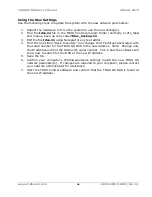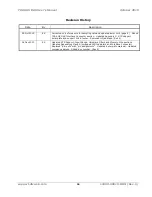
TDAS G5 DAS
User’s Manual
October 2019
16
11000-00010-MAN (Rev. 5)
Appendix C: Changing the TDAS G5 DAS Network Parameters
TDAS G5 systems communicate using the industry-standard Ethernet protocol. Your
TDAS G5 DAS was shipped with fixed IP address (
myip
) and subnet mask (
netmask
)
parameters already loaded in the flash memory of the microcontroller. The steps below
describe the process to change the
DAS unit’s
Ethernet parameters.
Note: This process
may require the help of your network administrator. If your in-house network support
person is not available, we encourage you to contact DTS for help.
CAUTION:
Great care should be taken when changing any network
parameters. The IP address and subnet mask should not be
changed without full knowledge of the impact on the
communication environment. If you have any questions, please
contact your network administrator for help.
Establish Communication
Using the TDAS Firmware Loader provided with the TDAS Control software, establish
communication with the DAS unit. To do this, change the fields to the appropriate
hardware (G5), serial number of the DAS unit, and communication method (Ethernet).
(You can
ignore the IP address field for the moment.) Click on the “Discovery” button
to search the network for the requested serial number. If the serial number is found,
the IP address field will be updated with the current address for that DAS unit. (This
step is performed to ensure that the computer and DAS unit are communicating.)
NOTE:
Both the computer and DAS unit must be on the same netmask
for
“Discovery”
to
be successful. If “Discovery” is not
successful, please contact DTS for assistance.
Change the Network Parameters
Once communication has been established, use terminal mode from the Utility menu
within the TDAS Control software to change the network parameters. The TDAS G5 DAS
boot firmware recognizes the following standard firmware parameters:
myip
specifies the target’s
IP address (
required
)
netmask
subnet mask (
required
)
gateway
gateway IP address (if needed
–
see your network administrator)
































